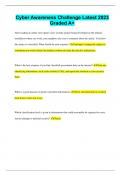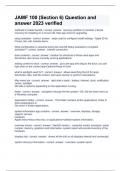Samenvatting
Summary SV The Immune System (Parham 4th) - Chapter 8
Deze Engelse samenvatting bevat een ruim overzicht van onderwerpen besproken in hoofdstuk 8 van Parham et al. 2012 'The immune System'. Onder andere: effector T-cel functie, de anti-virale response en inflammatoire mediatoren zoals interleukinen. Het bevat alle belangrijken concepten en definitie...
[Meer zien]














